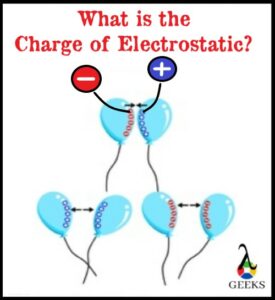The electrostatic charge is the charge exchange that happens when two surfaces either come in contact or separate. The article discusses about what is the charge of electrostatic and how to find it.
The electrostatic concept originated from a non-contact force that the charges employ on each other. It signifies the properties of slowing-moving charges as the force between them is large. The Coulomb law depicts such force as ‘electrostatic force’ that provokes charge exchange.
The charge moves slowly when it is in an electrostatic state or static equilibrium. It occurs when we rub the surfaces of two objects and then charge on each surface transfer to another surface. Before rubbing, any object is in a neutral state. i.e., its atom has an equal number of positive or negative charges.
But when we rubbed the surfaces, it gained either additional electrons or protons. When particles receive more positive ions than negative, they become positively charged particles. In these particles, the protons number is more than the number of electrons. Whereas, when particles acquire more negative ions, it becomes a negatively charged particles such as electrons.
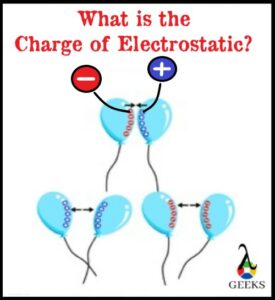

Electrostatic Example
Suppose we rubbed both neutral rod and silk cloth to each other. The negative charge moves from rod to the silk cloth, and the positive charge from silk cloth moves to the rod. That is how the net negative charge on the silk cloth counterbalanced the net positive charge on the rod. It is an electrostatic condition, whereas the force liable for such a condition is called ‘electrostatic force’.
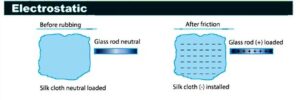
(credit: shuttertstock)
Like charges or similar charges oppose each other. i.e., negative charge repels negative charge or positive charge repels positive charge. Whereas unlike charges attract each other, i.e., positive charge attracts negative charge. Even though charges attract or repel, they are still binding each other inside the atom due to another non-contact force called ‘nuclear force’, which is stronger than the electrostatic force.
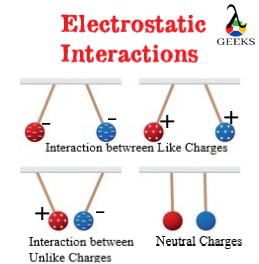
Read more about Types of Forces.
What is the Charge on Electrostatic Force?
The charge on electrostatic force is the like or unlike charge that causes repulsive and attractive force.
The electrostatic force is either repulsive or attractive, operating between unlike or like charged particles. It is repulsive if the charged particles after an exchange have the exact polarity. If they have an opposite polarity, then the electrostatic force is attractive.
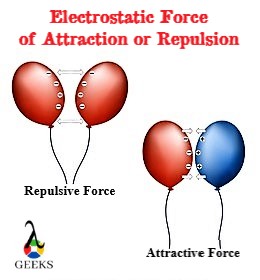
Since the charge is a fundamental property of the matter, its every component possesses a charge with a value that can be zero, positive, or negative. The proton, a positively charged particle, is bounded to the atomic nucleus by strong nuclear force, whereas the electron, a negatively charged particle, moves near the nucleus. That means, the sign of charged particles denotes whether the atom has extra electrons and a lack of electrons.
The electrostatic force between a positive proton and negative electron inside the atom is liable for the atom’s strength. It exerted over a distance of 10-6m, which is the one-tenth diameter of an atomic nucleus.
- Suppose a matter possesses the exact positive and negative charges, the force between charges has zero net charge.
- If two interacting charges, either positive and positive or negative or negative, the electrostatic force between charges is repulsive and has a positive ‘+’ sign. The positive repulsive force between two charges is weak. Hence, nuclear force is needed to bind both charges.
- If two interacting charges are positive and negative, the electrostatic force between charges is attractive and has a negative ‘-’ sign. The attractive negative force is sufficient to bind two unlike charges.
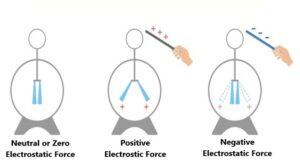
(credit: shutterstock)
What is the First Law of Electrostatic Charge?
The Coulomb law of attraction and repulsion is the first law of electrostatic charge.
The electrostatic force is called as ‘Coulomb force’ as is defined by Coulomb law which tells,
“The magnitude of the electrostatic force between two charges is directly proportional to the magnitude of both charges and inversely proportional to the square of the distance between them.”
The electrostatic force or Coulomb force between two interacting charges q1 and q2 separated by distance r is,
F ∞ q1q2/r2
F = keq1q2/r2
Where the constant of proportionality ke is the coulomb’s constant.
ke is equal to the 1/4πɛ0
Whereas the ɛ0 is electric constant having value of 8.85 x 10-12 C2/Nm2
And π= 3.14
Substituting all values,
ke= 1/4 * 3.14 *8.85*10-12
ke = 9 x 109 Nm2c-2
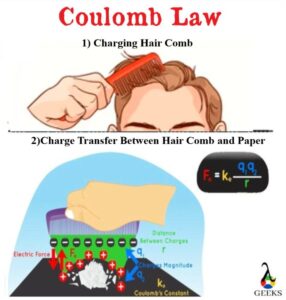
From (*), we learned the strength of the electrostatic force is changed by alerting the following two variables:
The magnitude of both charges
The more we charge an object, the better it attracts or repels each other. Suppose we assume positive charges on two rods. If we rubbed both rods little, it also barely increased the magnitude of positive charges on it. The rubbing improves the electrostatic force strength between two positive charges so that the charges repel more. If one of the rods gains a positive charge and the other gains a negative charge, both rods attract each other because of unlike charge transfer after rubbing.
The distance between charges
The more we raise the distance, the fewer charges attract or repel each other. If the rods are brought near to each other after rubbing, they attract or repel more as the strength of electrostatic force increases due to the small distance between charges. But the electrostatic force becomes near zero when we raise the distance between charges to infinitely large.
Since the Coulomb law of attraction or repulsion is the inverse-square law, i.e., force inversely proportional to distance, identical to Newton’s law of gravitation. The coulomb or electrostatic force is stronger than the gravity force, but both non-contact forces lower with the distance. Nevertheless, the gravity force is attractive, but the electrostatic force is either repulsive or attractive.
The magnitude and sign of the electrostatic force are described by the two interacting charges within an atom rather than an object’s mass.
How to Find Charge of Electrostatic?
The charge of electrostatic is discovered by the law of conservation of charge.
The conservation law states that electric charges do not create or destroy after rubbing; they transfer from one surface to another. It leads to transformations in the polarity of an object where the charge is transferred, and this transferred charge is known as the ‘charge of electrostatic’.

(credit: shutterstock)
As per the law of conservation of charge, q = ne
Whereas n is positive and negative integers depend upon a sign of charge, and e is electronic charge having a value of 1.60 x 1019 C.
So, a proton having a positive sign, has value q = + 1.60 x 1019 C and an electron having negative sign, has value q = -1.60 x 1019 C.
Electrostatic Example
Let’s introduce the positive or negative charges into the neutral object that has zero net charge, i.e., q = 0
Suppose we bring a positively charged rod with net charge +q = 6e near the neutral sphere. The positively charged rod has six protons that travel away from each other since it is repulsive. Hence their two protons transfer into a neutral sphere, making it positively charged with net charge +q = 2e, whereas the net charge of the rod becomes +q = 4e.
The total charges of the system of road and sphere before the transfer are 6e, and after the transfer is 6e. That’s how total charges of the system are conserved, and we can discover a charge of electrostatics after transfer.
Read more about Conservation Laws.
What is the Unit of Electrostatic Charge?
The unit of electrostatic charge is the Coulomb (abbreviated as C).
The unit of the electrostatic system is used to measure electric quantities like current, voltage, and charge. The force exerted on other charges defined the electrostatic charge in the electrostatic unit. The SI unit of electrostatic charge is Coulomb (C), and the CGS unit is Statcoulomb (statC).
1 C = 3.3 x 10 -10 statC.
In the System International (SI) units, the charges derive from the Coulomb law of attraction or repulsion, assuming the permittivity as a dimensionless quantity. The Centimetre-Gram-Second (CGS) unit, such as statcoulomb, is also known as the electrostatic unit of charge (esu) or franklin (Fr).
The primary reason for expressing the electrostatic charge into the CGS unit is to express other laws of electromagnetism.
Also Read:
